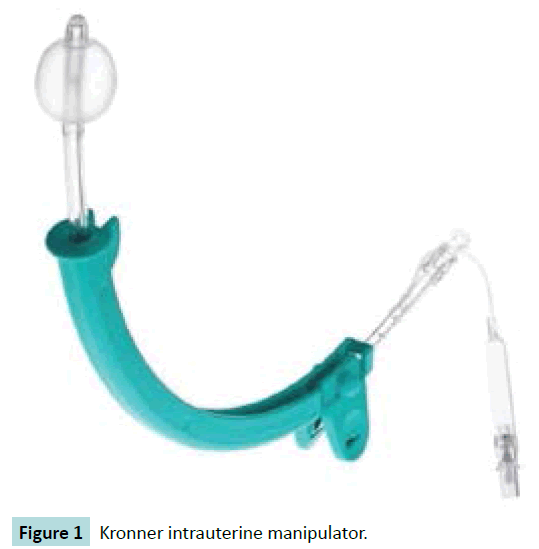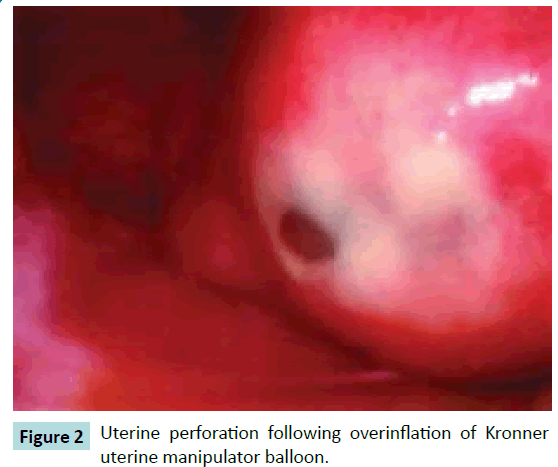Oroma B. Nwanodi1*, Stefan Novac2, Neekianund Khulpateea3
1College of Graduate Health Studies, A. T. Still University, Mesa AZ & Wyoming Medical Center, Casper WY, USA
2Memorial Hospital Miramar, Miramar FL, USA
3Maimonides Medical Center, Brooklyn NY, USA
*Corresponding Author:
Oroma B. Nwanodi
College of Graduate Health Studies, A. T. Still University, Mesa AZ & Wyoming Medical Center, Casper WY, USA
Tel: +1 307-577-7201
E-mail: o.nwanodi@juno.com
Received date: October 01, 2015 Accepted date: November 17, 2015 Published date: November 20, 2015
Keywords
Iatrogenic uterine perforation; Kronner uterine manipulator; Uterine manipulator balloon overinflation; Uterine perforation
Abbreviations
D&C: Dilation and Curettage; IUD: Intrauterine Device
Introduction
The RUMI and HUMI/Kronner uterine manipulators (RUMI® and HUMI®/Kronner® Uterine manipulator Injector, Cooper Surgical, Shelton, CT), the Clearview™ uterine manipulator (Clinical Innovations, Abingdon, England), and the Majoli uterine manipulator (Cook Group Inc, Spencer IN), are four of many tenaculumless manipulators used for uterine mobilization and chromopertubation that have both an inflatable balloon for securing the manipulator in place, and a patent channel for chromopertubation. Several uterine manipulators such as the Pelosi Uterine manipulator (Apple Medical Corporation, Marlborough, MA) and the Cohen Cannula (Richard Wolf, Vernon Hills, IL) that permit chromopertubation are balloonless, but incorporate a tenaculum. We are aware of two reported cases of iatrogenic uterine rupture due to overinflation of a RUMI manipulator, one of which necessitated a return to the operating room for retroperitoneal hematoma treatment [1].
The disposable Kronner uterine manipulator consists of one port for the intrauterine balloon which secures the manipulator in place and one port for chromopertubation, with a spring loaded platform in the handle of the manipulator (Figure 1). We report what to our knowledge based on searching the PubMed database using the search terms “uterine perforation,” and “uterine manipulator,” is the third case of iatrogenic uterine perforation due to overinflation of a uterine manipulator balloon (Table 1), and the first case of iatrogenic uterine perforation due to overinflation of a uterine manipulator at initial placement of the manipulator [1-4].
| Reference No./Year |
Manipulator |
Reason for Surgery |
Causation |
Outcome |
Cases |
| 4/2014 |
Hohl |
Endometrial hyperplasia |
Improper uterine sounding. Uterine perforation with Hohl uterine sound. Recto-sigmoid colon adherent to uterine fundus |
Bowel perforation. Uterine rupture. |
1 |
| 3/2007 |
KOH Colpotomizer or RUMI |
Not given |
Not given |
Uterine perforation. |
1 |
| Current publication 2015 |
Kronner |
Multiparity. Copper IUD use for 9 years |
Initial balloon overinflation |
Uterine perforation |
1 |
| 2/2007 |
Kronner |
Ovarian cyst |
Cervical conization for CIN III performed 5 days earlier. |
Uterine cervix perforation into the anterior cul-desac. |
1 |
| 1/2005 |
RUMI |
1-Primary Infertility 2-Pelvic pain |
Balloon port mistaken for injection port. Intrauterine balloon overinflation with methylene blue. |
1 and 2-Uterine perforation. 2-Retroperitoneal hematoma. |
2 |
Table 1 Reported cases uterine perforation with uterine manipulators.

Figure 1 Kronner intrauterine manipulator.
Case Report
A 37-year-old woman (gravida 4, para 2022) presented to her gynecologist with a one year history of pelvic pain beginning seven days prior to the onset of menstruation, dysmenorrhea for the first day of menstruation, menorrhagia, and postcoital spotting. She also complained of nocturia and urinary urgency. Her gynecologic history was significant for a dilation and curettage (D&C) in 1989, copper intrauterine device (IUD) use for 9 years following a normal spontaneous vaginal delivery of twins in 1996, conization of the cervix for a high grade squamous intraepithelial lesion in 2003, and ovarian cystectomy in 2005. Pelvic examination was normal with visible IUD strings. The IUD was removed. The Pap test was interpreted as atypical endocervical cells. Endocervical curettage showed benign endocervix with squamous metaplasia. Endometrial biopsy was interpreted as proliferative endometrium with fragments of fibromuscular tissue. Urine culture and cytology were negative for infection or malignancy. Transabdominal pelvic ultrasound showed a 6.8 × 4.1 × 5.6 cm uterus, a 6 mm endometrial stripe, a 4.1 × 2.6 × 2.5 cm right ovary, and a 4.4 × 3.4 × 1.7 cm left ovary. There was no free fluid in the cul-de-sac. She was offered cystoscopy to further evaluate overactive bladder, and a laparoscopic bilateral tubal sterilization to provide contraception in lieu of the IUD.
Intraoperatively, the uterus was sounded but not dilated. A Kronner uterine manipulator with a 30 ml syringe already placed on the balloon port, was handed off to a physician who did not normally place the uterine manipulator. Instead of only filling the balloon with 10 ml air, the entire capacity of the 30 ml syringe was used, filling the balloon with 30 ml of air. Following placement of the laparoscope, the Kronner uterine balloon was visible through a 1 cm diameter perforation of the uterine fundus (Figure 2). The Kronner uterine manipulator was removed vaginally, the rim of the perforation cauterized with bipolar cautery for good hemostasis, and Surgicel (Surgicel® Ethicon Inc, Piscataway NJ) placed. The bilateral tubal sterilization was performed with bipolar cautery. Cystoscopy was negative for Hunner’s ulcers or glomerulations. Postoperatively the patient had no further complaints of abnormal uterine bleeding.

Figure 2 Uterine perforation following overinflation of Kronner uterine manipulator balloon.
Discussion
To the best of our knowledge, this is the first reported case of iatrogenic uterine perforation due to overinflation of the Kronner uterine manipulator balloon at initial manipulator placement. Normally, a 10 ml syringe is used for inflation of the Kronner manipulator balloon. In this instance, a 30 ml syringe was inadvertently used. Unlike the two previously reported cases of uterine rupture with overinflation of a RUMI uterine manipulator balloon, overinflation of the manipulator balloon was not due to mistaking the balloon port for the chromopertubation port [1]. While the normal uterine capacity is 2 to 20 ml, up to 40 ml of saline may be used for balloon tamponade after hysteroscopic resection of myoma, and up to 300 ml of saline for postpartum hemorrhage intrauterine balloon tamponade [5,6]. Thus, overinflation with 30 ml of saline may not be the sole cause of the fundal uterine perforation. Our patient’s uterine fundus may have been weakened from 9 years of IUD usage. Uterine perforation is a well known adverse effect of intrauterine devices [7]. Alternatively, perforation could have resulted from the initial sounding of the uterine cavity, with the overinflated Kronner uterine manipulator balloon simply enlarging the uterine perforation. Inserting the uterine manipulator through an nonmechanically dilated cervix, could also have contributed to a fundal uterine perforation. However, there was no indication intraoperatively that perforation occurred with either sounding the uterus or insertion of the uterine manipulator.
Occult perforation can occur at the time of D&C, as is reported to be the case in several instances of occult uterine perforation discovered at cesarean section [8,9]. However, in our case the patient successfully delivered a term twin pregnancy vaginally without complication 7 years following a D&C, which may suggest that in this case there was not an occult uterine perforation from the patient’s prior D&C.
Unsuspected uterine perforation may be revealed at laparoscopy [8]. While previously, in cases of unsuspected uterine perforation, the actual perforation was believed to have occurred during D&C, currently, laparoscopic or abdominal myomectomy and operative hysteroscopy may be more frequent causes of occult uterine perforation [10]. Uterine perforation may also occur during laparoscopy due to trocar puncture, or to the uterine sound [11].
In the case presented, the patient’s operative course was minimally altered due to the uterine perforation, and there were no post operative sequela to the patient. However, uterine rupture due to overinflation of a uterine manipulator balloon can lead to extended postoperative hospitalization for procedures that were anticipated to be ambulatory, or a return to the operating room for treatment of an acute abdomen [1]. In teaching institutions, or when gynecologic laparoscopists do not work with a consistent operating room team, there must be close adherence to manufacturers’ instructions, or consideration given to using balloonless uterine manipulators, such that potentially serious adverse events may be avoided.
References
- Wu HH, Yeh GP, Hsieh TC (2005) Iatrogenic uterine rupture caused by overinflation of RUMI manipulator balloon. J Minim Invasive Gynecol 12: 174-176.
- Sung P-L, Chao K-C, Twu N-F, Wang P-H, Yu BK-J, et al. (2007) Post conization cervical perforation during laparoscopic surgery. Taiwanese Journal of Obstetrics and Gynecology 46(1) 71-72.
- Ng CCM, Chern BSM, Siow AYM (2007) Retrospective study of the success rates and complications associated with total laparoscopic hysterectomy. Journal of Obstetrics and Gynaecology Research 33: 512–518.
- Akdemir A, Cirpan T2 (2014) Iatrogenic uterine perforation and bowel penetration using a Hohlmanipulator: A case report. Int J Surg Case Rep 5: 271-273.
- Yu D, Li T, Xia E, Huang X, Zheng J (2006) A prospective randomized controlled trial on the effectiveness of routine Foley balloon tamponade on the reduction of bleeding after hysteroscopic resection of myoma. Gynecol Sur 3:93-6.
- Condous GS, Arulkumaran S, Symonds I, Chapman R, Sinha A, et al. (2003) The "tamponade test" in the management of massive postpartum hemorrhage. Obstet Gynecol 101: 767-772.
- Van Houdenhoven K, van Kaam KJAF, van Grootheest AC, Salemans THB, Dunselman GAJ (2006) Uterine perforation in women using a levonorgestrel-releasing intrauterine system. Contraception 3:257-60.
- Reed W (2003) Large Uterine Defect Found at Cesarean Section. A Case Report. J Reprod Med 48:60-2.
- Bagga R, Goel P, Prasad GR, Gupta I (1997) Fetus papyraceous covering the site of uterine perforation found during caesarean section. Aust N Z J Obstet Gynaecol 37: 360-361.
- Sentilhes L, Sergent F, Berthier A, Catala L, Descamps P, et al. (2006) [Uterine rupture following operative hysteroscopy]. Gynecol Obstet Fertil 34: 1064-1070.
- Intaraprasert S, Taneepanichskul S, Chaturachinda K (1997) Outpatient laparoscopic interval female sterilization. Contraception 55: 283-286.



